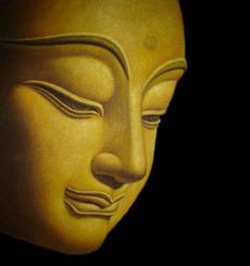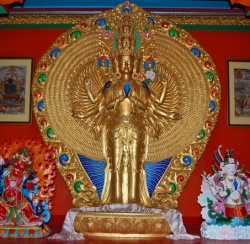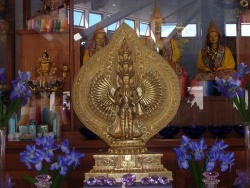Two Practices of Impermanence
Preface
The aim of Buddha's teachings is to free us from attachments and limited views so that we may become pure in mind and live happily and spontaneously. In order for Buddha's teachings to penetrate our lives and minds and ultimately bring about a spiritual rejuvenescence, we need to adopt some Buddhist practices on a daily basis. Prior to adopting any Buddhist practice, one needs to be reminded of the fact of impermanence of life.
Having impermanence in mind helps us become free from worries and more appreciative of what we all have in common. Consequently, a feeling of being "in the same boat" would grow and lead to cooperation and harmony.
Without being mindful of impermanence we tend to make wishful and elaborate plans which in the end prove to be delusive and useless, not to mention the emotional roller coaster that we ride through when the experiences of life are filled with expectations and disappointments. Without a vivid realization of the impermanence of all things in life, including life itself, we tend to be incessantly engulfed in our thoughts, emotions and relationships. For many of us a reminder of impermanence will serve as the wind that clears the cloudy sky.
Over the years I have found two practices of impermanence very effective. One is the keeping of a "record of impermanence", and the other is to take walks in a cemetery.
I use a small notebook to write down the name of deceased ones that I have had acquaintance with in person; and the notebook is called a "record of impermanence." In this booklet I present the English version of an essay, originally written in Chinese and published in 1988, on this practice.
Following the practice of my late guru Yogi Chen, I am accustomed to visiting cemeteries in order to pray for the dead. My residence is in the vicinity of a cemetery; hence I have gradually formed the habit of taking a walk in the cemetery for my daily exercise. In the cemetery I choose to walk along the rows of tombstones and read them one by one. Each time I leave the cemetery I notice that the walk has had a cleansing effect on my mind. Such walks turn out to be not just a physical exercise but also a spiritual one. In this booklet I present my reflections on this practice in lyric form; they are entitled, appropriately enough, "Learning from the Dead."
Sometimes when I walk in the cemetery I carry lighted incense sticks, chant "Amitabha," and scatter rice as nectar for the dead. But the main point of this practice is to read with one's heart the inscriptions on the tombstones.
Learning from the Dead
I
As I walk in the cemetery
I read the tombstones one by one;
Although only a few lines each
To a careful eye they tell many stories.
II
All the things that we worry about, fight for or accomplish,
In the end are reduced to two dates of birth and death!
When we live we are separated by status and households;
When we die we come here to lie down side by side.
III
The dead are my real teachers;
They teach me through their eternal silence!
A walk through the cemetery simply dissipates all my worries.
The dead cleanse my mind by the vivid example of their existence!
IV
Suddenly I see that life could end at any moment!
Once I realize that I am so close to death I am instantly free in life.
Why bother to criticize or fight with others?
Let me just be pure in mind and enjoy living!
V
Anyone we come across is sure to be
With us for only this moment;
Let us be kind to each other
And make life a merry-go-round!
VI
May all who are lost in the sorrows and worries of life,
Wake up to the fact of the closeness of death!
Once you see impermanence face to face,
You will enjoy peace and freedom for life!
Keeping a "Record of Impermanence"
On February 10, 1988 it occurred to me that keeping a record of the names of all those deceased people whom I had met in person would help awaken in me a keen sense of impermanence. To a full-time Buddhist practitioner like me it would be very beneficial. I found a small blue-covered 1987 daily notebook in my drawer, so I made use of this unused but out-dated notebook. On the first page I entitled it "A Record of Impermanence" and in the daily blank I filled in names that I remembered.
As I put down each name, past events began to emerge in my mind one by one. There were some whose names were no longer remembered, so instead I put down a name for the relationship; some whose names were unknown to me, so I put down a brief description; and some even passed away before they were named. Some I met only once; some I was with for years. Some whose death came as a surprise from thousands of miles away; while others' were a gradual daily face-to-face good-bye. Some died of sudden illness; while others died of lingering sickness. Some committed suicide because of difficulty in school; while others because of an unhappy marriage. Some were murdered by business partners; while others were killed by romantic competitors. Some died in the womb; some died in infancy; some died a teenager, like a flower in bud; some died suddenly in their prime years; some died in the snare of old age and sickness; some died in the quietness of a long and peaceful life. At age forty-one I alone had witnessed such a vast variety of cases of impermanence.
Facing the fact of impermanence and considering that every moment there are thousands of people passing away, I intuitively realized the futility of worldly arguments and competitions. How I wished to use such a transient and precious life-time to offer some positive contributions to the world.
I put this record of impermanence, with its pages open, on the altar near the lotus seat of Green Tara--a transformation of the great compassionate Bodhisattva Avalokitesvara (Kuan Yin). I lit an incense stick and prayed that these deceased ones would be blessed by Buddhas and Bodhisattvas, especially by the Green Tara, and thereby attain liberation from the sufferings of transmigration.
That night, just before I fell asleep, as my thoughts had quieted down, suddenly I sensed that I had held a subtle delusive thought in the past that death was not my problem. Such a delusive thought might well be present in the minds of many of us without our realizing its presence. After all, death seems to be so distant from the reality of our on-going daily life. Earlier that day I came to face the concrete cases of impermanence and thereby unintentionally shattered the delusive thought I had carried. Delusive thoughts are hiding deep down in our consciousness and obscuring our perspectives, hence they are hardly recognizable. Only at the moment of their shattering can we get a fleeting glimpse of them.
Immediately following this intuitive realization came another: At the moment of death we are to separate from everything in the world. This may be obvious to anyone who reflects on death; nevertheless, I had never had such an awareness arising from the depth of my mind. We need to practice being detached from all things lest we suffer at the end. Otherwise, as we look back, at the moment of death, we will realize that our lives have been infested with worries and quarrels over insignificant trivialities. What a waste it is! Whenever I am entangled by sorrows in my mind I would think: If this is the final moment of my life and I am entangled by these matters, would my life be worthwhile? Such a reflection usually pulls me right out from my sorrows, and the sky looks blue and sunny again!
The next morning I discovered that the incense stick I had lit and offered for my prayer, although completely burned, remained whole with its body turning in a recurving way and its head pointing toward the right hand of the statue of Green Tara. Her right hand extends downward with an open palm, signifying her salvation activities. I took a picture of it and the photo is reprinted in this booklet. In this photo the blue cover of my record of impermanence can be seen at the seat of the Green Tara. To me, this inspiring occurrence indicated Buddha's compassionate blessing in answer to my prayers for the deceased ones, and approval of the practice of keeping a record of impermanence.
Since that day I have continued to keep my records of impermanence. Whenever people ask me to do Powa (a Buddhist tantric practice to transfer the consciousness of deceased ones to the Pureland of Buddha) I also enter the name of the deceased in my book. Although I had not met all of them in person, by doing Powa for them I established a wonderful Dharma connection. Besides, Powa is for the benefit of the deceased ones, and naturally reminds us of the reality of impermanence, of its immediacy and unpredictability. (By the way, sometimes when I did Powa for deceased people, I saw them appear before me.) Some of the names in the record were entered sporadically later because only then they sparked my memory. This shows that although impermanence of life is a reality, nevertheless, in our normal daily life it is very easy for us to neglect and forget about it. The practice of keeping a record of impermanence would constantly remind us of the reality of impermanence, lest we indulge ourselves in insignificant worldly pursuits and suffer from resulting turmoil. It would help safeguard the purity and freshness of our minds so that wholesome ideas would sprout and grow into kindness and compassionate activities.
To learn arithmetic thoroughly we should not only be able to do exercises in the book but also be able to apply it to real-life situations. Keeping a record of impermanence is not only to practice Buddha's teaching of being mindful of impermanence but also to connect the teaching with our personal experiences to benefit us on a down-to-earth level. Only by unifying the theoretical with the practical can we actually receive the essence of Buddha's teachings. Since the cases of impermanence that we put into writing are ones that we have actually witnessed, been personally involved in, and even suffered for, they have tremendous impact on us and carry with them supreme power of persuasion. My awakening to the presence of delusive thoughts in me is a good example of the effectiveness of this practice.
There are many practices of impermanence in Buddhism. For example, meditations on death (to meditate on the certainty of death's arrival, the unpredictability of the time of death, one's helplessness and loneliness at the moment of death, etc.), observation of the changing scene of our mental activities, chanting Buddha's name near someone who is passing away, and visiting cemeteries to pray for the dead. Keeping a record of impermanence can be an easy but helpful addition to the other practices. This record is to be placed on the altar so that the deceased ones are under the blessing of Buddha and thereby we may practice an act of great compassion. As we write down the names, we do not distinguish between friends or foes, family members or acquaintances; therefore, it is also a practice of equal-love-for-all.
I hope that everyone who reads this article will adopt this practice and thereby share its effective benefits.
Source
Dr. Yutang Lin
edited by Ann Klein
typed by Chun Jane Chen
yogichen.org





